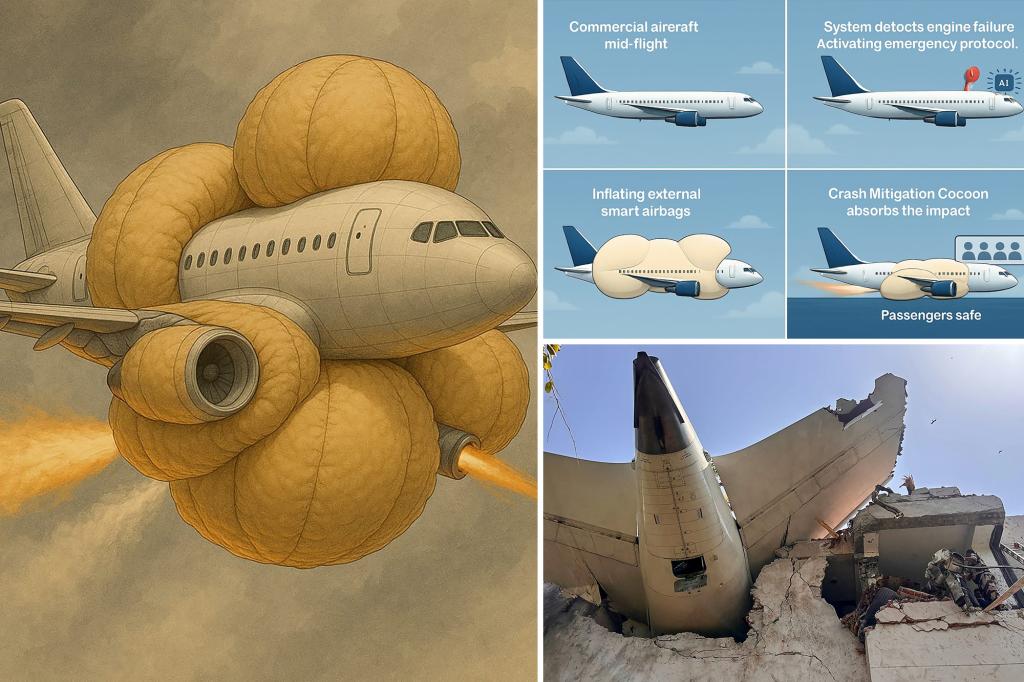Aircraft Airbags: A Promising Innovation Born from Tragedy
In the aftermath of the devastating Air India Flight 171 crash, a groundbreaking safety innovation has emerged that could fundamentally transform aviation safety. Project REBIRTH, an AI-powered aircraft safety system featuring external airbags, has been selected as a finalist for the prestigious James Dyson Award. Created by engineers Eshel Wasim and Dharsan Srinivasan from the Birla Institute of Technology and Science’s Dubai campus, this invention was inspired by profound personal emotion and a commitment to saving lives. Though the concept of airplane airbags might initially seem far-fetched—conjuring images of aircraft resembling the Michelin Man or giant pieces of popcorn—the technology represents a serious attempt to transform fatal crashes into survivable incidents, potentially saving hundreds of lives annually.
The inspiration behind Project REBIRTH comes from a place of deep empathy and grief. Following the June 2025 Air India tragedy in Ahmedabad that claimed 241 lives, one of the creators revealed the emotional catalyst for their innovation: “After the crash, my mother couldn’t sleep. She kept thinking about the fear the passengers and pilots must have felt, knowing there was no way out.” This sense of helplessness drove the engineering duo to channel their emotions into practical research and design. Rather than accepting the fatalistic notion that certain aircraft failures are unsurvivable, they questioned why survival mechanisms aren’t already standard in aviation. Their vision transcended pure engineering to become “a response to grief” and “a promise that survival can be planned, and that even after failure, there can be a second chance.” This human element distinguishes Project REBIRTH from being merely another technical aviation advancement—it represents a profound desire to eliminate the helplessness felt in catastrophic situations.
The technical sophistication of Project REBIRTH lies in its comprehensive approach to crash survival. At its core, an advanced AI monitoring system continuously tracks critical flight parameters including altitude, speed, engine status, direction, fire incidents, and pilot responses. This constant vigilance allows the system to make intelligent decisions during emergencies. When a crash becomes “unavoidable below 3,000 feet,” the system automatically triggers deployment of external airbags, though pilots retain override capability. These specially designed airbags, constructed from layered fabric, deploy “from the nose, belly, and tail in under 2 seconds,” creating a protective cocoon around the fuselage to absorb impact forces. The system’s intelligence lies in its ability to distinguish between different emergency scenarios and respond appropriately, potentially transforming what would be fatal accidents into survivable incidents regardless of aircraft velocity.
Project REBIRTH extends beyond external airbags to form a comprehensive safety ecosystem. The engineers have incorporated additional protective measures that work in concert with the airbag system. If engines remain functional during an emergency, the system activates reverse thrust to slow the aircraft’s descent. When engines fail, gas thrusters automatically engage, reducing speed and improving stability by 8-20%. Inside the cabin, impact-absorbing fluids installed behind walls and seats remain soft during normal operations but instantly harden upon impact—a remarkable material science application that significantly reduces passenger injuries. This multi-layered approach demonstrates the engineers’ understanding that aviation safety requires redundant systems working in harmony. Perhaps most impressive is the practical implementation strategy: the system can be retrofitted to existing aircraft or incorporated into new designs, making widespread adoption feasible.
The path from concept to implementation presents significant challenges, but Wasim and Srinivasan have outlined a clear strategy for moving forward. They plan to partner with aerospace laboratories to conduct rigorous crash sled and wind tunnel testing—essential steps in validating the system’s effectiveness. While no specific release timeline has been announced, the engineers have expressed their commitment to seeing REBIRTH “tested, approved, and used in real flights.” The project’s selection as a James Dyson Award finalist provides crucial visibility and potential funding; winners, to be announced on November 5, receive over $40,000 and support for business development. However, the engineering team has emphasized that their motivation transcends financial rewards: “This competition is our first step in bringing our vision forward—not for recognition, but with the hope that one day, it may help save lives when all else fails.” This sentiment reflects the profound human motivation driving their innovation.
Project REBIRTH represents a paradigm shift in aviation safety philosophy. While most safety innovations focus on preventing accidents, REBIRTH acknowledges that despite best efforts, catastrophic failures sometimes occur. By creating technology specifically designed to make the unsurvivable survivable, Wasim and Srinivasan challenge the aviation industry’s acceptance of certain crash scenarios as inherently fatal. Their innovation speaks to the human desire to protect life even in seemingly hopeless situations. As this technology progresses through development and testing phases, it carries with it not just engineering excellence but the emotional weight of its inspiration—the fear experienced by those who knew they had no escape. If successful, Project REBIRTH could transform this narrative, ensuring that even in worst-case scenarios, passengers and crew maintain hope for survival. What began as a response to one mother’s sleepless nights of worry may ultimately provide peace of mind to millions of air travelers worldwide.














